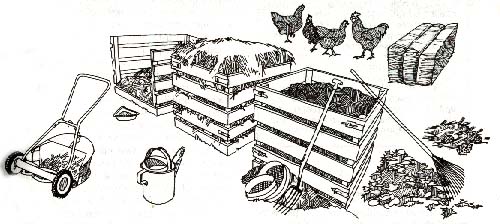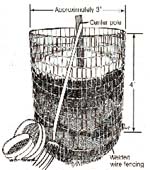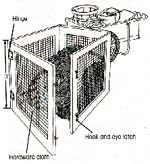
Garden Chat Notes
Topic: Composting

Our Garden Pathway
Our Message Board
Our Chat Room

Anyone can have a good compost. You have good compost ingredients all
around you. In your backyard you have grass clippings, pine needles and
cones, dried leaves, some of you even have hay, and manure. In your kitchen
you have food scraps, and coffee grounds.
Heidi suggested this topic. Composting is one of the most valuable things you
can do in a garden. Enriching your soil, while at the same time reducing the
waste stream which helps the environment.
Jim does a large composting operation that he uses a tractor to move around.
He adds fertilizer to help it decompose faster.
Mars has a small compost operation similar to the one pictured above.
Connie: I would like to do one on a very small scale.
mars: There are lots of ways to build compost bins, you can use chicken wire,
pallets, or get one of the barrels that you turn with a handle. You have
to decide if you want it to look nice. I use pallets for mine. I wire them
together on the sides to form a square.
There are some basic principles in making a compost that works..
Ingredients: Anything of living origin can be composted.
Moisture: All living organisms need water, but too much washes away nutrients.
Good compost is about as damp as a moist sponge.
Aeration: Supplying enough air to all parts of a compost pile to encourage
thorough decompostion is perhaps the key to successful composting. Turning
it often is the the most straight forward way of doing this, but there are other
aerating techniques that can also be employed.
Temperature and Critical mass: Too large a pile interfers with aeration, but a minimum size of 3' in each dimension is needed in order fro heating to occur.
Structures: Last but not least important is the stucture of the composting area.
There are many ways to build a structure, depending on the materials you have
on hand. Below are some pictues of some simple structures you can easily
make yourself.

This compost bin is nothing more than a piece of 10'tall
x 4' wide welded wire fencing, connected at the ends
with wire to form a cirlce just larger that 3' accross.
To turn the compost pile you just remove the fencing,
set it back up next to the free-stanting pile of compost-
ing materials and refill the now empty bin.
In the picture there is a center pole to direct moisture
into the center of the compost pile.

This is a wood and wire compost bin. Construct a 3'x3'
portable bin using four sides made of 3'x3' pieces of
1/2" hardware cloth fastened to 2x4s. Hinge one of the
sides and place hooks and eyes on the edge opposite the
hinges, creating a door for your bin. Set up this bin
close to your garden; when the bin is full, move it to
another convenient location and begin a new pile.
If you have a small yard, and will only be producing a small amount of waste
for your compost, a small circle of ridged wire fencing is all that is nessessary.
You can also make a very simple composter with a garbage can.
Simply cut out the bottom of a trash can and set the can firmly in the ground.
Drill air holes in the sides and lid to provide aeration to keep the system
working and encourage earthworms to inhabit your garbage can composter.
You can use several such cans for continuous waste composting; simply wait
six months to a year, depending on your climate, for the finished product.
Chopping your wastes first speeds up the process, as does occasional turning
or fluffing of the can's contents.
Connie: What about bad smells from the compost bins?
mars: They don't have to smell bad if they are working properly.
Connie: Do the ingred. have to be layered and how do you get it hot enough?
mars : The waste products I put into my compost just sort of end up
in layers anyway, and the first time it gets turned, it all gets
mixed up anyway.
JimW : It gets hot as it is breaking down, it creates it's own heat. Air and
water are important. I use commercial fertilizer to help mine heat
up also.
Connie: How often do I need to turn the pile?
Jim: It depends on the size of the pile, small piles need to be turned more
often then the large ones.
Connie: Is a 4'x4' compost bin a good size to start with?
Jim: You would have to have a way to turn a pile that large Connie,
that is a big pile to have to turn with a shovel and pitchfork.
mars: That is the size I started with, now I have four bins that size. I turn
the contents of one bin to the next when it is time to turn the pile. I
turn my pile with a pitchfork.
Connie: Do you have to water it if you do not get enough rain?
Jim W: Yes, moisture is very important.
Connie: mars, what do you have in your compost bin?
mars: I start my pile with very light brush to help with aeration then the
stuff from my kitchen and garden go in. I always make sure to get
some garden soil and a few earthworms in there too.
I also have some horse maure and barn cleanings from the next
farm over. I have my chicken house cleanings in there, which is
sawdust, hay and chicken poop. I also add the green grass from
when we mow the yard.
Connie: This is going to be an interesting adventure.
Jim: The manure is what supplies the nitrogen that heats up the pile.
mars: An old timer from around here suggested I dump in coke when I
first started my pile because I couldn't get it to heat up. It worked!
I think it must have been the sugar.
To continue with the chat
Our Garden Pathway
Our Message Board
Our Chat Room